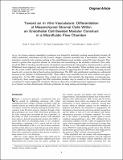Toward an In Vitro Vasculature: Differentiation of Mesenchymal Stromal Cells Within an Endothelial Cell-Seeded Modular Construct in a Microfluidic Flow Chamber
Author(s)
Chamberlain, M. Dean; Sefton, Michael V.; Khan, Omar Fizal
DownloadKhan-2011-Towards an _i_in vit.pdf (791.9Kb)
PUBLISHER_POLICY
Publisher Policy
Article is made available in accordance with the publisher's policy and may be subject to US copyright law. Please refer to the publisher's site for terms of use.
Terms of use
Metadata
Show full item recordAbstract
An in vitro tissue construct amenable to perfusion was formed by randomly packing mesenchymal stromal cell (MSC)-embedded, endothelial cell (EC)-coated collagen cylinders (modules) into a microfluidic chamber. The interstices created by the random packing of the submillimeter-sized modules created EC-lined channels. Flow caused a greater than expected amount of contraction and remodeling in the modular constructs. Flow influenced the MSC to develop smooth muscle cell markers (smooth muscle actin-positive, desmin-positive, and von Willebrand factor-negative) and migrate toward the surface of the modules. When modules were coated with EC, the extent of MSC differentiation and migration increased, suggesting that the MSC were becoming smooth muscle cell– or pericyte-like in their location and phenotype. The MSC also proliferated, resulting in a substantial increase in the number of differentiated MSC. These effects were markedly less for static controls not experiencing flow. As the MSC migrated, they created new matrix that included the deposition of proteoglycans. Collectively, these results suggest that MSC-embedded modules may be useful for the formation of functional vasculature in tissue engineered constructs. Moreover, these flow-conditioned tissue engineered constructs may be of interest as three-dimensional cell-laden platforms for drug testing and biological assays.
Date issued
2011-10Department
Koch Institute for Integrative Cancer Research at MITJournal
Tissue Engineering. Part A
Publisher
Mary Ann Liebert, Inc.
Citation
Khan, Omar F., M. Dean Chamberlain, and Michael V. Sefton. “Toward an In Vitro Vasculature: Differentiation of Mesenchymal Stromal Cells Within an Endothelial Cell-Seeded Modular Construct in a Microfluidic Flow Chamber.” Tissue Engineering Part A (2011): 111202114038003. Web. 16 Feb. 2012. © 2011 Mary Ann Liebert, Inc.
Version: Final published version
ISSN
1937-3341
1937-335X